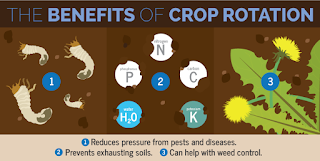Crop Rotation: Crop Choices for Row Crops
The Row Crop Cultivation
Generally, crop rotation is a
“system of growing different kinds of crops in recurrent succession on the same
land” (Martin, Leonard, and Stamp, Principles of Field Crop Production, 1976).
Thus, in the strictest sense, crop rotation is more than just changing crops
from year to year based on current economic situations. Rather, it is a
long-term plan for soil and farm management.
Figure
1: Three crops in a corn in a corn-soybean-wheat/red clover rotation.
First
of all, row crop cultivation can be a very
good weed control technique. It works well to control weeds that are growing
between rows of crops; one of the main things that make row cultivation good is
that it can be used when the weeds are rather large (up to 15 cm tall). Most
other in crop weed control techniques that are used work best when weeds are
only at the cotyledon stage. With that being said row crop cultivation solves
weed problems that could be “out of control” because of this techniques
aggressive approach. All that row crop cultivation means is that it is a
cultivator that is set up to cultivate down the large inter-rows in crops that
are typically row crops; it turns the soil and breaks up the weeds. Producers
who grow row crops use this technique; some row crops that row cultivators are
used in are corn, soybeans, potato, field bean, and many other horticulture
crops.
Figure
2: One of a Row Crop Tractor.
Next, row crop cultivation works best
when the field does not have too much residue from the previous crop because if
your cultivator gets plugged up with crop residue. This can build up and begin
to drag and can possibly damage the crop that is growing and also not penetrate
the soil well and defeat the purpose of killing weeds. But some of the new
cultivators are better at dealing with crop residue and can still work fairly
well in high residue fields. Row cultivation also works well when the weeds are
bigger because it allows you to kill more of the weed population and it is
still effective whereas many other in crop tillage practices must be done when
the weeds are small.
Figure 3: The row crop cultivation.
Figure 4: The row crop mono-culture.
Figure 5: The row crop poly-cultures.
Furthermore, the best way to avoid
problems when using row crop cultivation is to ensure that you have a good GPS
system not only when cultivating a field but also when it is being seeded. If
you are not perfectly straight in the field and your GPS lines get out by a
small amount you can start having problems with damaging your crops. Not only
is the GPS important but also knowing your depth your cultivator is working at
and understanding the rooting systems of the crops being grown so that you can
avoid damaging roots.
Figure 6: The
GPS System for row crop.
Lastly, row
crop cultivation is not a very expensive weed control technique. Row crop
cultivators are not overly expensive and even a normal cultivator can be
converted to a row crop cultivator. Usually one pass with a row crop cultivator
is enough to control the weeds depending on the growing season; if it is a wet
year you may need to make more than one pass because there will be more weeds.
But if it is a dry season then turning the soil to control weeds cannot be as
beneficial because drying out the soil to control the weeds may not give you as
good of a yield increase if water is limiting. You also need to take into
consideration the fact that cultivation can cause erosion in some cases and can
see yield losses later on down the road if erosion is bad.
PREPARED BY:
NAME: MOHD
FIKRY BIN IBRAHIM.
NUMBER CARD
MATRIX: 2018261652.
REFERENCES:
1)
Jeremy
Singer, Agricultural Research Service, Ames, IA, Phil Bauer, Agricultural Research
Service, Florence, SC, Last modified - June 11, 2009. http://soilquality.org/practices/row_crop_rotations.html#what
2)
Brenda Frick, Crop Cultivators Textbook.
Chapter 28, 2014. https://words.usask.ca/plsc243/management-techniques/tillage/tillage-in-crop/interrow-cultivation/
3)
SOUTHERN STATE, Farmed own
since 1923. https://www.southernstates.com/articles/starting-a-small-row-crop-farm.aspx









Comments
Post a Comment